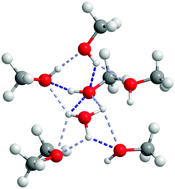Electron-driven ionization of large methanol clusters in helium nanodroplets
Abstract
The electron-driven ionization of helium droplets doped with pure

* Corresponding authors
a
Institut für Ionenphysik und Angewandte Physik, Universität Innsbruck, Technikerstr. 25, A-6020 Innsbruck, Austria
E-mail:
Paul.Scheier@uibk.ac.at
b CAPES Foundation, Ministry of Education of Brazil, Brasília – DF 70040-020, Brazil
c Departamento de Física, ICE, UFJF, Campus Universitário, Juiz de Fora, Brazil
d
Department of Chemistry, University of Leicester, University Road, Leicester LE1 7RH, UK
E-mail:
Andrew.Ellis@le.ac.uk
The electron-driven ionization of helium droplets doped with pure

 Please wait while we load your content...
Something went wrong. Try again?
Please wait while we load your content...
Something went wrong. Try again?
M. Goulart, P. Bartl, A. Mauracher, F. Zappa, A. M. Ellis and P. Scheier, Phys. Chem. Chem. Phys., 2013, 15, 3577 DOI: 10.1039/C3CP43826K
To request permission to reproduce material from this article, please go to the Copyright Clearance Center request page.
If you are an author contributing to an RSC publication, you do not need to request permission provided correct acknowledgement is given.
If you are the author of this article, you do not need to request permission to reproduce figures and diagrams provided correct acknowledgement is given. If you want to reproduce the whole article in a third-party publication (excluding your thesis/dissertation for which permission is not required) please go to the Copyright Clearance Center request page.
Read more about how to correctly acknowledge RSC content.
 Fetching data from CrossRef.
Fetching data from CrossRef.
This may take some time to load.
Loading related content
